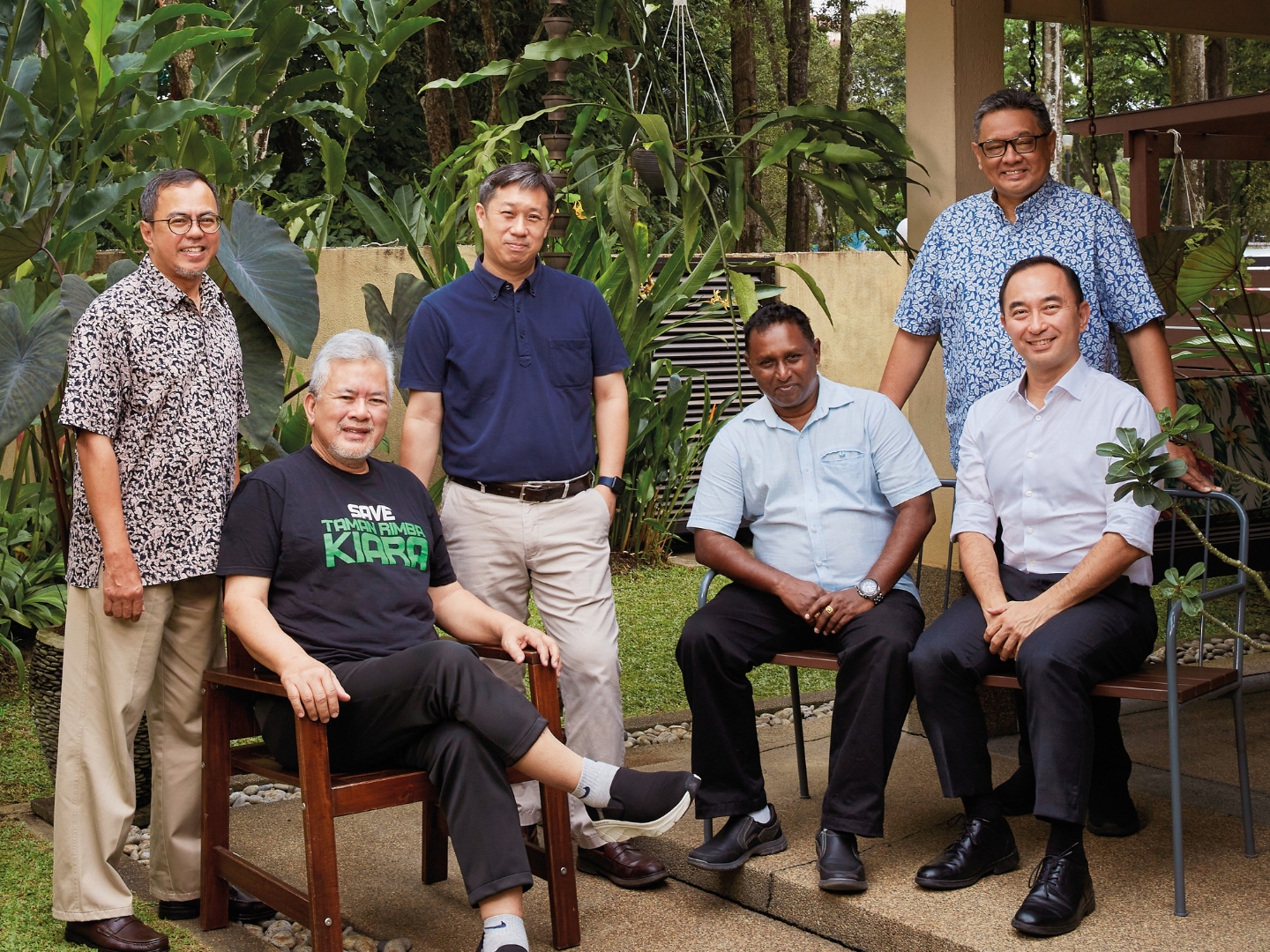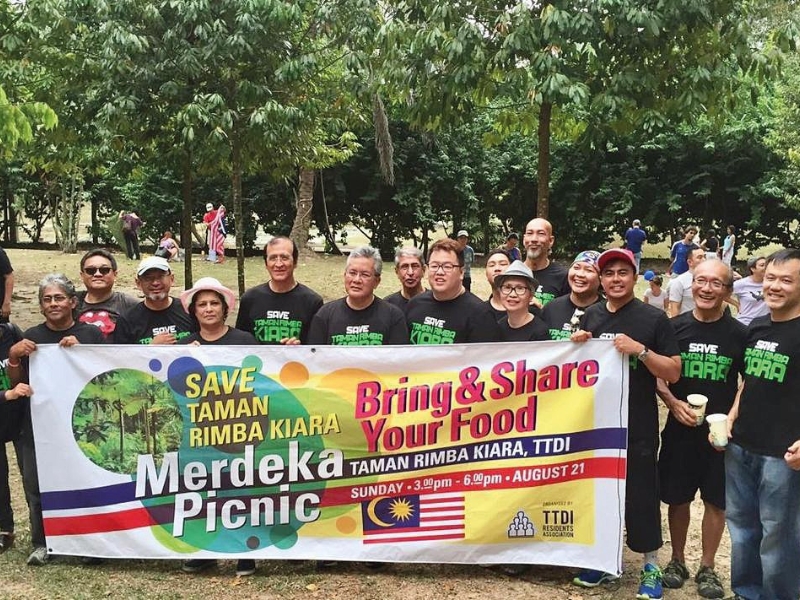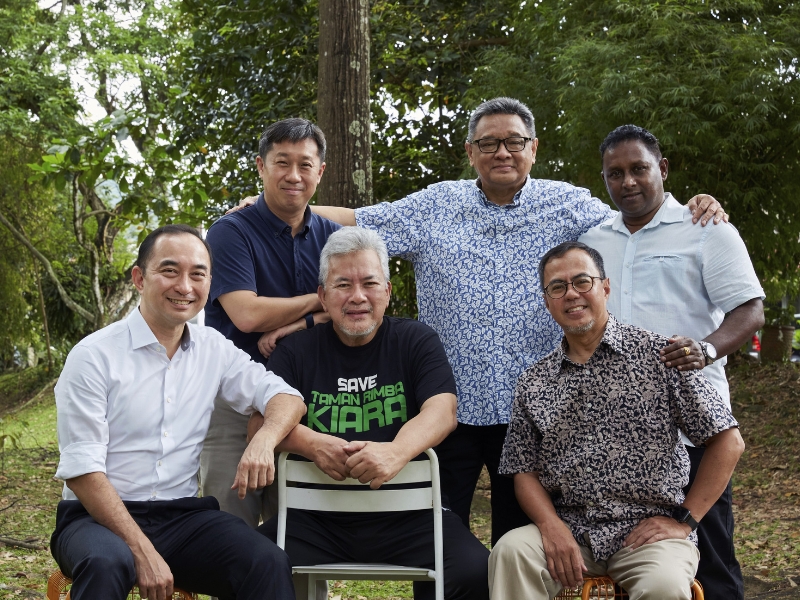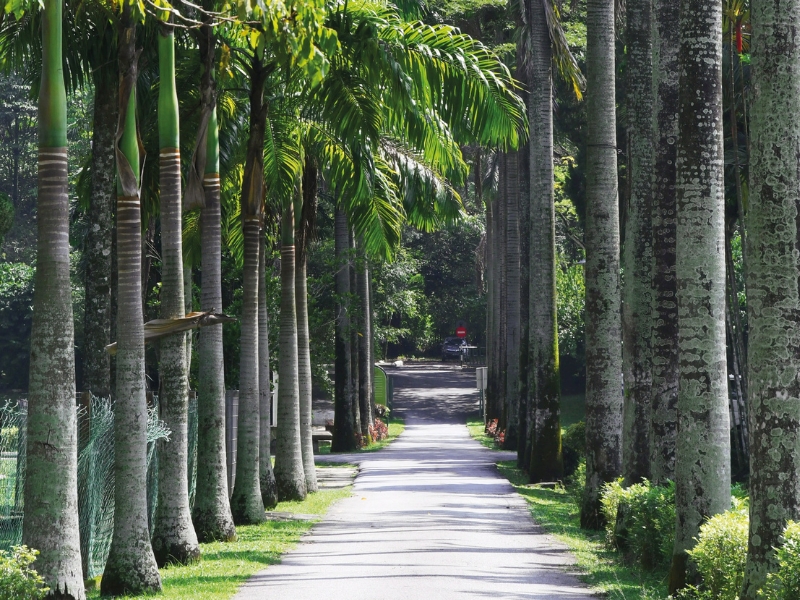
Save TRK's working committee (from left): Azlinshah Othman, Abdul Hafiz Bakar, Clinton Ang, Sivakumar Muniandy, Khairudin Rahim and Leon Koay (Photo: SooPhye)
Athletes complete a race when they breast the tape. A community of residents engaged in what qualifies as a legal marathon can see the finish line. What holds them from crossing it together and claiming victory is a promise made 43 years ago that has yet to be fulfilled.
The pledge involves permanent housing for workers relocated in 1982 from Bukit Kiara to temporary longhouses at Taman Rimba Kiara (TRK), Kuala Lumpur, after the federal government acquired the rubber estate. They are still waiting.
TRK in Taman Tun Dr Ismail (TTDI) was gazetted as a public park and green open space under the KL Structure Plan 2020. In 2014, half of its 25 acres were quietly transferred for private development. The plan was to build eight blocks of 42- to 54-storey luxury condominiums and a 29-storey block of affordable housing for the longhouse residents on that land parcel.
The Federal Territories Foundation (Yayasan Wilayah Persekutuan, or YWP), the landowner of TRK, had signed a joint venture with Memang Perkasa Sdn Bhd to use the land for a mixed-use development. The latter paid RM160 million to YWP, chaired by then Federal Territories minister Tengku Adnan Tengku Mansor, to ensure things went smoothly. When Kuala Lumpur City Hall (DBKL) issued the development order in 2017, TTDI residents, who had found out about the project from a notice put up on-site a year earlier, protested vehemently. After their objections fell on deaf ears, they sought legal recourse.
After seven years of protracted hearings, the community won the case. First, when the High Court dismissed their lawsuit, they turned to the Court of Appeal, which decided in their favour. In 2023, DBKL lost its appeal to reinstate the proposed TRK development when the Federal Court ruled that the development order was unlawful and the city park is for everyone and will remain intact. Last year, the Cabinet directed DBKL to maintain the greenery in TRK and construct permanent housing for the 98 longhouse families.
Elated but not done yet, the Save TRK team says its fight to put things right has not stopped, as there is still Part Two: new quarters on the current four-acre footprint for a long-suffering group who wonder whether that will ever happen.
The saga of how a community locks arms to counter authority for justice is the stuff of movies, but the story is for real in TTDI. On March 22, BFM rolled out Rumah Penantian, a 30-minute documentary video that recaps how the issue unfolded, takes viewers into the homes of the longhouse dwellers and talks to those who helped uncover the covert actions of local authorities that did the group wrong. The hope is that people caught in a similar situation elsewhere can take a leaf from TRK and do something about it.
“The problem arose because the longhouse community has not been treated properly. This story can end well only if we have a fair solution for them,” says Khairudin Rahim, part of the Save TRK team.
“We want to show people there are avenues [for action] if you come together. But you need to do some work first — like know what a structure plan is, understand planning laws, public consultation and processes.” If a parcel of land has been designated for a specific purpose, any proposed development that contradicts this designation provides strong grounds for objection, he adds.
What stoked his initial reaction was fury. “I got very angry at the audacity of those involved for wanting to pull wool over our eyes by taking land meant for the public and switching it to commercial use without telling anybody, thinking they could do whatever they liked. In a way, anger kept us going despite the setbacks.”
Going to court was far from their mind initially. “Where were we going to get the money?” But when public protests, petitions and appeals got them nowhere — “As far as the authorities were concerned, the deal was done” — they had no choice but to change tack.
After forming a working committee, the residents galvanised their entire infrastructure to oversee certain things. Various residents helped shoulder different tasks. “Because I happen to be from advertising, my job was to coordinate press statements and inform the media of what we were doing, and being available when they called. We have to put things out in the public to get them moving. If we keep them under wraps, nobody knows and nothing will move,” Khairudin explains.
“We are fortunate to have believers and good people in Taman Tun who were committed. Residents came forward. Many contributed but didn’t want to come out publicly. When we did funding, the people responded, quite a number anonymously. It really took the entire community to move this.
“What we have here is something phenomenal. Everybody came together, residents, associations, communities, individuals, professional bodies, lawyers, Members of Parliament and the press, which did analytical, investigative reports that opened up everybody’s eyes to what was going on.”
trk_gathering.jpg

Two years after the apex court decision, the team continues to do their part to advocate the government to honour its original promise to the longhouse community.
Khairudin says they had held a town hall meeting and gathered architects, town planners, surveyors and engineers, who were asked to come up with possible permanent housing solutions on the current footprint, based on residents’ needs. These experts surveyed the location and suggested different plan configurations.
“There are other options that can be explored. The ball is in the government’s court; it has the options and tools available. Which one is it going to pick up and which does it think it can deliver? But the question remains: Is there political will to focus on [doing] the right thing?”
Talking about options, there are also developers who may want to step up and assist the authorities in making a neglected community’s hopes come true, he reckons.
“We’re not asking them to do it pro bono, but if they do, we will welcome that. This is an opportunity to demonstrate significant ESG initiative. It’s environmental because it means preserving a park. It’s social because it concerns the needs of a long-suffering community. And it will help correct deficits in governance and deliver something that is within the rules.” Well, any takers?
The longhouse dwellers hope the matter will be settled as quickly as possible under the present government administration. “We see the finish line and we’d like to proceed, all of us together, because, really, that would be a fair and just ending to this saga,” Khairudin says.
trk_committee.jpg

On another tangent, the TRK working committee points out issues that need to be examined further, such as transparency, accountability and suspicious dealings.
Under their joint venture, YWP and Memang Perkasa, a Malton Bhd subsidiary, had to obtain DBKL approval to develop TRK. In its 2021 ruling, the Court of Appeal observed that the applicant and the approving body were the same. The then DBKL mayor was part of the Land Exco, which made the decision to alienate the 12-acre parcel to YWP, its welfare arm. He was also on the board of YWP, which gave certain guarantees and commitments for the project.
There was clearly a conflict of interest: YWP taking land gazetted as a public green space and parcelling it out for high-end condos worth billions of ringgit. “Did no one notice this? Did anyone speak up?” Khairudin asks.
In 2019, the Malaysian Anti-Corruption Commission (MACC) was reported as saying it had started investigations on those linked to the proposed park development. What have they found so far and what has happened since? Who approved the development order? Is anybody bringing any case against them? Is MACC doing anything to help the public?
That same year at a town hall meeting with the TTDI community, Segambut MP Hannah Yeoh had asked why MACC was taking so long to take action, despite residents’ multiple reports that the TRK project was tainted with graft.
Also, had Tengku Adnan and the mayor’s conflicts of interest as chairman and YWP board member, respectively, been vigorously scrutinised or pursued after the appellate court ruling that these relationships gave rise to bias? Did MACC take any serious steps to freeze accounts or other pre-emptive action to preserve evidence that might be used for a deeper investigation?
As Khairudin and his cohorts seek answers to these and other pointed questions, people are finding their way to TRK, which is getting popular, says Save TRK team’s strategy lead, Leon Koay. Occasionally, it is still confused with the nearby Taman Persekutuan Bukit Kiara.
Quite a number of visitors have held functions there, including weddings and celebrations. Others go daily for various activities. Yet others especially relish the fact that it is a bit secluded, like a sanctuary. “That’s the whole point of a meaningful green space — it doesn’t have to be crowded all the time,” says Koay.
His parents, who are not from KL, use the park regularly for their walks because it reminds them of their hometown. The pandemic showed that we need green spaces, he says, adding: “To some extent, TRK is also personal for all of us because these places matter for us, our children, families, friends and, similarly, the longhouse community.”
tkr_shot_2.jpg

Sivakumar Muniandy, secretary of the Bukit Kiara Longhouse Residents Association, looks forward to the day when neighbours will stop asking him, “When are we getting our houses?”
“Whenever I meet them at any function, that’s the first thing they ask. It’s painful and very frustrating that I have no answers because I want something good for my people.”
Siva was 11 when his parents were moved to the longhouse in 1982. “The units were already there when we came; they were open, about 300 sq ft, with no rooms or ceiling. Everyone had to build their own partitions, and an upper [level] for storage. In big families, the children sleep or study up there.”
In Rumah Penantian, residents talk about being crammed, things falling apart, pipes that leak, poor sewerage and having to sleep outside for lack of space.
It is hoped that, in the near future, these challenges will be but distant memories as the community settles into new homes — able to look back on a time when they grew up amid lush greenery, and when strangers became friends while standing together to protect public space for their community and posterity.
It is a powerful story of unity and resilience worth retelling and a reminder that right can, indeed, triumph as might.
This article first appeared on May 12, 2025 in The Edge Malaysia.


